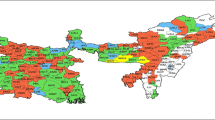Abstract
The time domain approach, i.e. Autoregressive (AR) processes, of time series analysis is applied to the monsoon rainfall series of India and its two major regions, viz. North-West India and Central India. Since the original time series shows no modelable structure due to the presence of high interannual variability, a 3-point running filter is applied before exploring and fitting appropriate stochastic models. Out of several parsimonious models fitted, AR(3) is found to be most suitable. The usefulness of this fitted model is validted on an independent datum of 18 years and some skill has been noted. These models therefore can be used for low skill higher lead time forecasts of monsoon. Further the forecasts produced through such models can be combined with other forecasts to increase the skill of monsoon forecasts.
Similar content being viewed by others
References
Akaike H. (1971), Auto-Regressive Model fitting for control,Ann. Inst. Stat. Maths.,23: 163–180.
Box G.E.P. and Jenkins G.M. (1976),Time Series Analysis Forecasting andControl, Holden-Day, Cakland, 57 pp.
Brown T. J. and Fluck J. A. (1987),Exploratory time series modelling and prediction of equatorial Pacific warming and cooling events Tenth Conference on Prob. and Statistics in Atmospheric Sciences, Canada,A. M. S., 178–182.
Chu P.S. and Katz R.W. (1985), Modelling and Forecasting the Southern oscillations—A time domain approach,Mon. Wea. Rev.,113: 1876–1888.
Elliot W. P. & Angell J. K. (1987), The relation between Indian Monsoon Rainfall, the southern oscillation and Hemispheric air sea temperature, 1884–1984,J. Clim. Appl. Meteol.,26: 943–948.
Gowariker, V. V., Thapliyal, V., R. P. Sarker, G. S. Mandal and D. R. Sikka (1989), Parametric and power regression models—New approach to long range forecasting,Mausam,40: 115–122.
Jolliffe I. T. (1983), Quasi-periodic meteorological series and second order auto-regressive processes,J. of Climatology,3: 413–417.
Katz R. W. and Skaggs R. H. (1981), On use of Autoregressive-Moving average process to the meteorological time series,Mon. Wea. Rev.,109: 479–484.
Kendall, M. G. and A. Stuart (1966),The advanced theory of statistics, Vol. 3, Griffin, London, 585 pp.
Normand C. (1953), Monsoon seasonal forecasting,Quar. J. Roy. Met. Soc.,79: 463–473.
Pankratz Alan (1983),Forecasting with univariate Box-Jeckins models concept and cases, John Wiley, New York, 562 pp.
Pant, G. B., Rupa Kumar K., Parthasarathy B. and Borgaonkar H.P. (1988), Long term variability of the Indian Summer Monsoon and related parameters,Adv. Atmos. Sci. 5(4): 469–481.
Parthasarathy, B., Sontakke N. A., Munot A. A., Kothawale, D. R. (1987), Drought/Floods in the Summer Monsoon Season over different meteorological subdivisions of India for the period 1871–1984,J. of Climatology,7: 57–70.
— (1990), Vagaries of Indian Monsoon and its relationships with regional/global circulations,Mausam,41: 301–308.
Thapliyal V. (1982), Stochastic dynamic model for long range prediction of monsoon rainfall in Peninsular India,Mausam,33: 399–404.
— (1986), Long Range Forecasting of Monsoon Rainfall in India,LRF Research Series 6 (III), WMO/TD87: 723–732.
— (1990), Long Range Prediction of summer monsoon rainfall over India: Evolution and development of models,Mausam,41: 339–346.
Theil H. (1966),Applied Economic Forecasting, Amsterdam, North Holland Publishing Co.: 26–32.
WMO (1971),Climate Change, Tech. Note No. 79 (annex III) Geneva, 63–69.
Yao C. S. (1983), Fitting a linear Auto-regressive model for long range forecasting,Mon. Wea. Rev. 111: 692–700.
Author information
Authors and Affiliations
Additional information
Part of this study is published in LRF Report No 14, Programme on Long Range Forecasting Research, WMO/TD no. 395 (1991), pp. 67–72.
Rights and permissions
About this article
Cite this article
Dahale, S.D., Singh, S.V. Modelling of Indian monsoon rainfall series by univariate box—Jenkins type of models. Adv. Atmos. Sci. 10, 211–220 (1993). https://doi.org/10.1007/BF02919143
Received:
Revised:
Issue Date:
DOI: https://doi.org/10.1007/BF02919143




